Tested: 2022 Volkswagen Arteon Is the Right Sedan at the Wrong Time
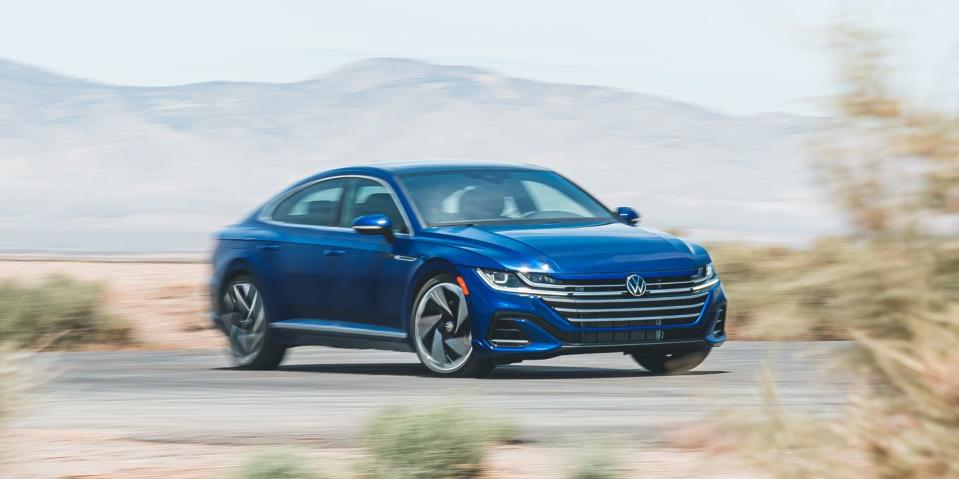
The 2022 Volkswagen Arteon is a great sedan. But is that good enough to attract shoppers who are in the thrall of SUVs? Is it good enough to justify its rather exorbitant pricing? At least in this inventory-starved moment, the answer is yes, but what happens when the industry finds some semblance of normalcy? It's possible the Arteon will meet the same fate as another expensive and luxurious VW sedan: the Phaeton.
Let's set our wild speculations aside for a moment and just enjoy the 2022 VW Arteon for what it is. The styling is attractive without seeming desperate for attention. If you were to try and describe its front fascia to someone, the massive grille might conjure thoughts of the Toyota Avalon or Camry, but the Arteon's is executed with so much more panache. The headlights feature accents that harmoniously incorporate them into the grille's horizontal strakes. The graceful fastback-sedan profile has echoes of the (somewhat-related) Audi A7, while the rear reminds us of the substantial and simple last-generation A8.
Is the Arteon the VW Group's middle ground between VW and Audi? Well, our top-trim vehicle's as-tested price of $51,240 certainly suggests that. So does its interior.
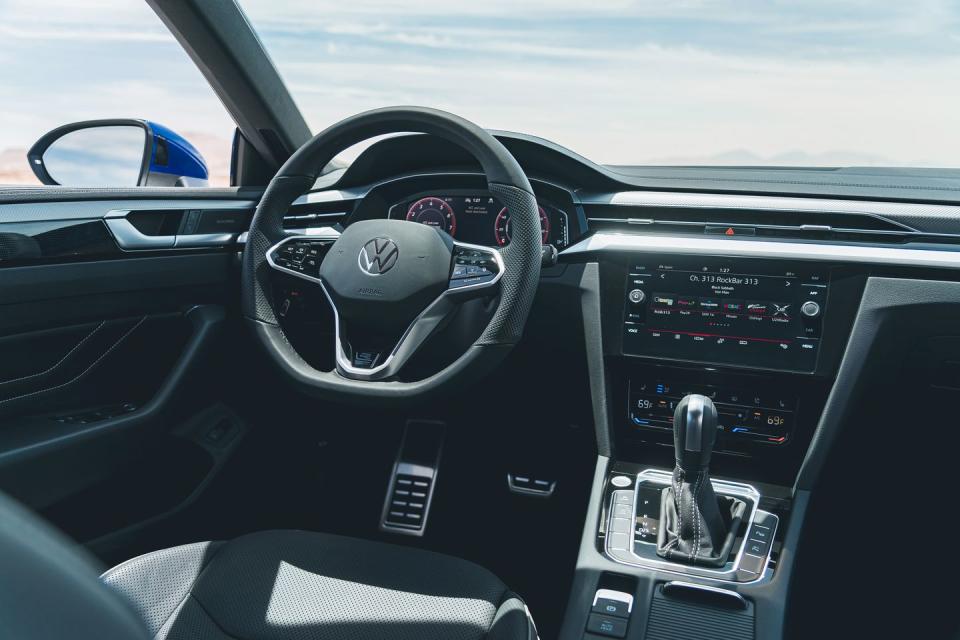
Cover up the VW badge on the steering wheel and you'd be forgiven if you mistake the Arteon for a last-generation Audi, both in terms of design and materials quality. The dash is appropriately modern with an understated and dignified interpretation. The digital instrument panel and 8.0-inch central touchscreen display sharp graphics, while piano-black plastic surfaces are tastefully minimal. Our only minor complaint is the use of some bright metal trim that can cause annoying sun reflections.
Part of our fondness for the Arteon's interior can be attributed to the minor makeover it received last year. The aforementioned digital display replaces the analog gauges, and the superfluous analog clock is gone from the top-center of the dash. For 2022, the Arteon sustains its momentum by giving all models a more aggressive personality with an R-Line design theme.

The biggest change for the 2022 Arteon, however, is its drivetrain. Lurking under the shapely hood is a slightly detuned version of the turbocharged 2.0-liter four-cylinder found in the spritely VW Golf R. It produces a healthy 300 horsepower and 295 pound-feet of torque, fed through a seven-speed dual-clutch automatic transmission. VW's 4Motion all-wheel-drive system is standard on all but the base SE R-Line trim. Despite the more powerful engine, fuel economy is barely affected. The EPA estimates the all-wheel-drive Arteon will return 22 mpg city/30 mpg highway compared to last year's 20/31 mpg figures. Our 21-mpg average included plenty of spirited mountain driving.
In everyday driving, there's a noticeable delay and surge of power upon initial throttle application. Whether it's turbo lag, lazy clutch engagement, or a combination of the two, it can be off-putting at first. After a short time behind the wheel, however, you get used to these subtle lurches. When driven conservatively, it may seem a bit weak, but just a bit more pedal pressure results in a sizable increase in power. When pushed into more daring territory, the engine responds appropriately with a smooth surge of acceleration, giving the Arteon an easy and approachable character.
What we didn't realize was that this easygoing facade hides an athletic side, as though your affable family friend turned out to be a former Olympic medalist.
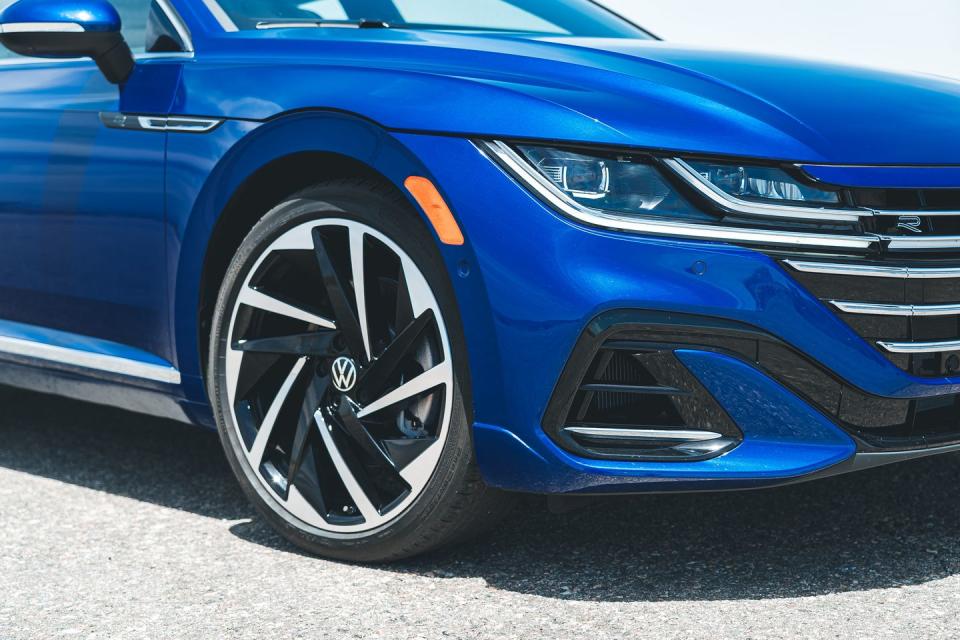
The Arteon we tested last year accelerated to 60 mph in a respectable 6.4 seconds. Based on the specs, an increase of 32 horsepower and 37 pound-feet of torque shouldn't drastically improve performance for a near-4000-pound sedan. We thought an improvement of a few tenths was in order. With the assistance of a 4000-rpm launch-control sequence, what we got instead was a 60-mph time of only 4.6 seconds, which is as impressive as it was improbable considering this car's mild street manners. In the quarter-mile, this Arteon crossed the line in 13.3 seconds at 103 mph, compared to its predecessor's 14.7-second run at 96 mph.
To its credit, the fun isn't limited to a straight line. On the ribbons of asphalt snaking through the Santa Monica Mountains, the Arteon proves that it's also fun in the curves. All-wheel drive is your friend here, particularly in first-gear hairpins and quick left-right-left transitions. It's no sports car, but the Arteon handles better than nearly any non-luxury-branded sedan, so long as you have all-wheel drive.
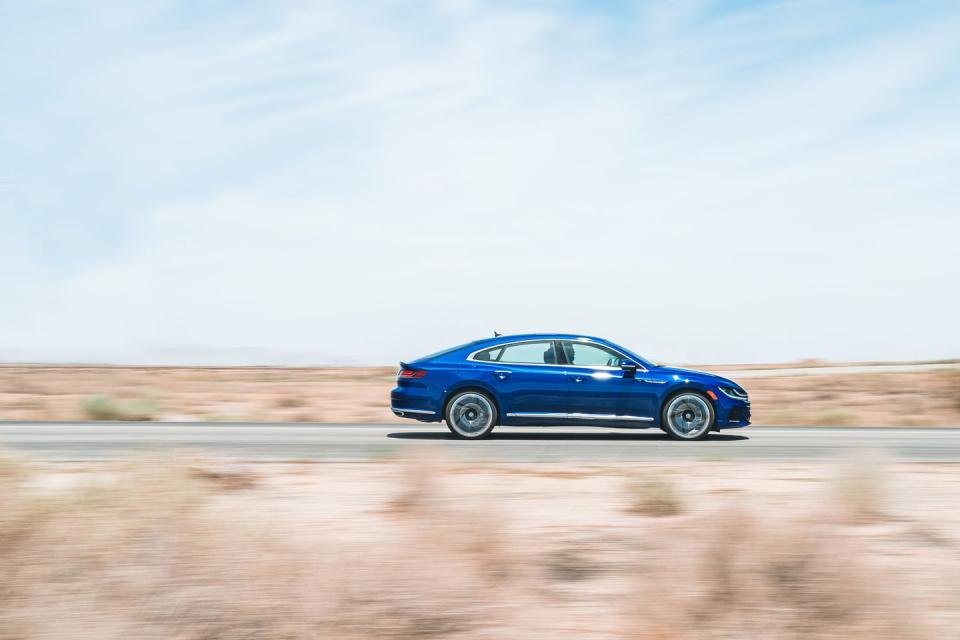
The base SE R-Line trim with front-wheel drive tells a very different story. Actually, the tires tell you through a constant howl that reverberates off the canyon walls. It feels as if it's on 20-year-old rubber, even though they're the same Continental all-seasons as the AWD version. It takes a lot more finesse to keep the front wheels from spinning and the sedan on your intended line. We admit that's still fun in its own right, but it certainly doesn't instill confidence. Midcorner bumps result in some unsettling shimmies, which the all-wheel-drive Arteon also exhibits but to a lesser degree.
Regardless of how many wheels are driven, it's a good idea to snap the shifter into Manual mode and make liberal use of the shift paddles if you want to have this kind of fun. Otherwise, the transmission is too eager and impatient to get into the higher gears, leaving you disappointed when you try to power out of turns. Sport mode helps somewhat, but the engine still tends to get bogged down.
The Arteon's ride quality is compliant over broken pavement and bumps while remaining taut and willing to carve through turns, with standard adaptive dampers helping the car find an optimal balance of comfort and performance.
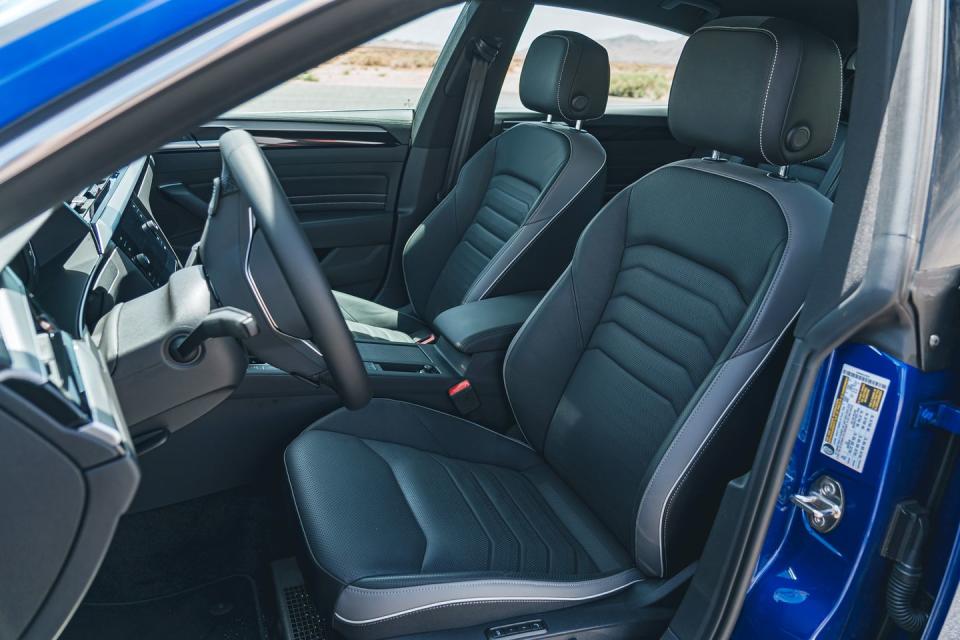
The front seats are similarly balanced, providing decent lateral support and adequate cushioning for longer drives. Ventilated seats are included in the top trim, along with a massage function, but the gentle kneading is only for the driver and only in the seatback. Helping to further reduce fatigue, the cabin remains free of road and wind noise at highway speeds. The rear seats, despite their flat appearance, are well padded, and they can accommodate passengers as tall as five feet nine without them brushing the headliner.
We're more impressed by what's behind the rear seats. The big hatch opens wide to reveal a huge cargo area. Its 27-cubic-foot capacity is only a cubic-foot smaller than the VW Taos SUV. Stowing the rear seats expands that capacity to a generous 56 cubic feet, and the 40/20/40 split-folding sections provide plenty of flexibility.
The Arteon's cockpit has a tech-forward style, but some basic operations can be perplexing. We like to think of ourselves as technically proficient, but it took us a few minutes to just find the odometer (it was hidden by the cruise-control indicator). Displaying the navigation map is also oddly difficult, requiring a few taps until we finally hit the right combinations. Finding your way through the menus is further complicated by the use of icons instead of labeling.
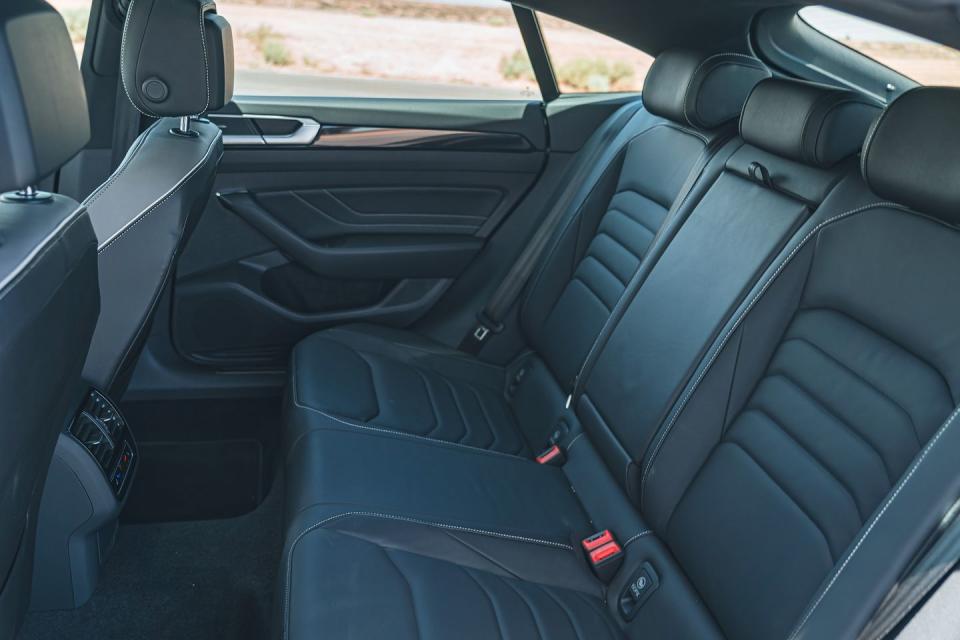
The infotainment system is a little slow to boot up; reactions could be quicker too. The menus take some getting used to, but they make more sense over time. That said, we prefer the familiarity of Apple CarPlay or Android Auto, which is typical for most vehicles today.
We usually recoil at the sight of capacitive-touch buttons, but our fears turned out to be unfounded here. The steering-wheel controls require a deliberate tap to activate, and the sliders for volume and track/channel skip aren't as overly sensitive as other brands. The temperature controls aren't as easy to use; that's due to their positioning low in the center stack, though. This is an instance where a rocker switch or knob would be better.
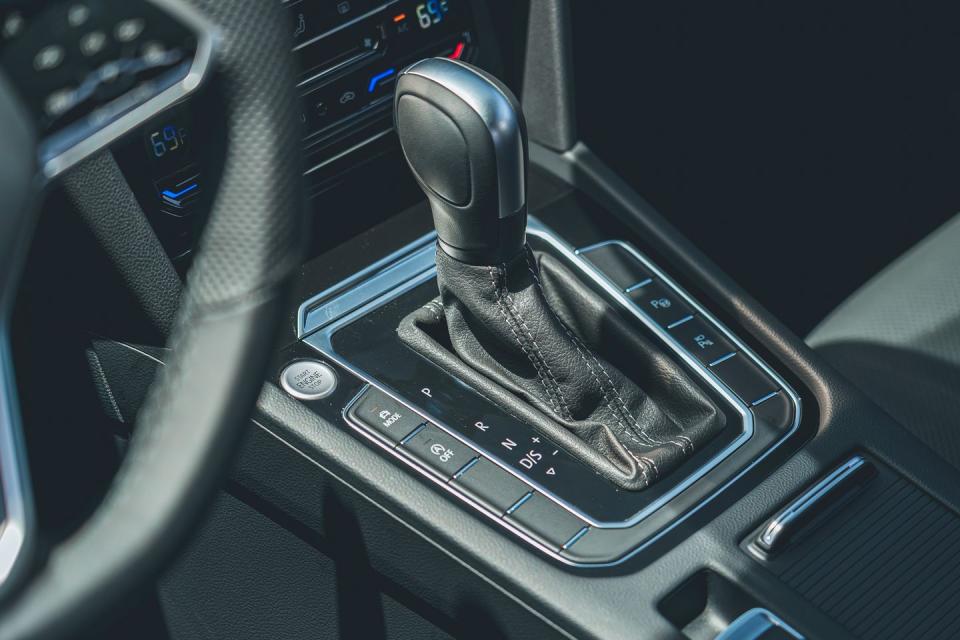
If you're getting the impression that we're nitpicking the Arteon, you're right, and that's a good sign. There's really nothing that strikes us as a critical error in the way this car looks or drives, leaving us with the nagging questions posed at the top of the review. It indeed should be good enough to lure shoppers away from an SUV, thanks to its quick acceleration, sporty handling, and huge cargo hold. It's also refined enough inside to justify its price, but the reality is the market turned its back on sedans years ago.
And that is the real tragedy. The 2022 Volkswagen Arteon is worth your attention. It's the kind of car you'd turn around to catch one last glimpse of before walking away. We had similar pangs of affection for the Kia Stinger when it debuted four years ago, and like that sporty fastback sedan, this is a great car at the wrong time. Perhaps one day we'll look back with the same fondness as we do for the Phaeton today. We're glad the Arteon exists in this 2022 form. If you agree, we suggest acting quickly before it's gone.

You Might Also Like

 Yahoo Autos
Yahoo Autos 